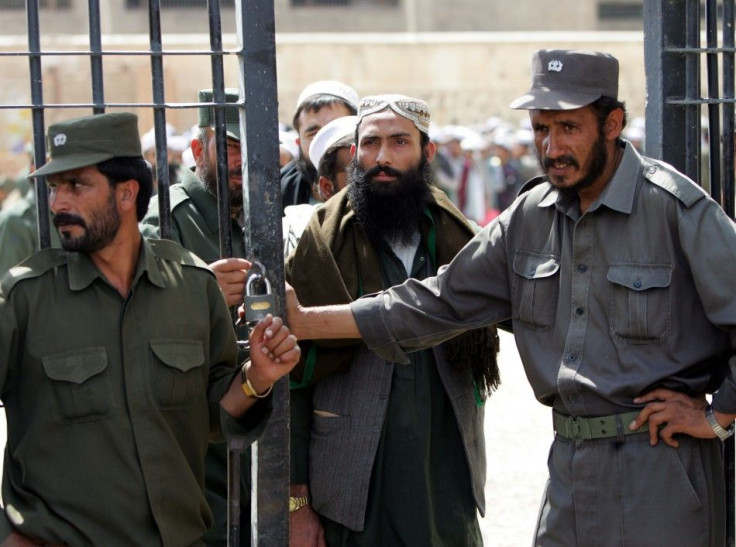'Systematic Torture' Rampant in Afghanistan Jails: U.N.

Afghan security forces and police have been torturing detainees at nearly 50 different detention centers, the United Nations reported Monday.
The U.N. Mission in Afghanistan interviewed prisoners held by both the Afghan National Police (ANP) and the National Directorate of Security, many of whom reported that they were tortured, beaten and subject to devices like electric shocks during interrogation sessions.
[Those] suspected of being Taliban fighters, suicide attack facilitators, producers of improvised explosive devices, and others implicated in crimes associated with the armed conflict in Afghanistan, were abused in detention centers across the country, the report found. The practice was reportedly not ordered (and not known) by the Afghan government.
The practices listed in the report break international laws. Both the NATO coalition and the Afghan government consider the report to be a serious issue, and Afghan police commanders have launched an investigation.
About half of the pre-trial detainees interviewed were suspected of being insurgents, and 20 percent were arrested with explosives while 11 percent were confirmed as failed suicide bombers. After ten years of occupation, Afghanistan is still rife with violence and militants attack government installations and civilians nearly everyday.
However, the interrogation methods used by Afghan police were cruel and inhumane and took place during every stage of the arrest process. The U.N. also found that the ANP mistreated and abused a number of boys and teenagers.
One detainee, code-named Detainee 365, told the United Nations that police beat him to extract a confession.
I was interrogated at [an NDS facility in Kandahar]... They hit me 20 or 25 times. They beat me mostly on the bottom of my feet, just once they hit me on the side of my legs. Two people would hold me in the air, they tied my legs together, two people would lift my legs up into the air and lift my feet. They would then beat my feet [with a steel cable], the soles of my feet, while my feet were held in the air. It was very painful, and I was already injured from the previous day (when he was knocked unconscious by a kick to the head).
While they were beating me like this, they asked me questions, they repeated the questions before, saying that I told them I was a Talib. I told them I was not aware I said I was a Talib, I told them that I didn't know what I told them. They said to me just tell us you are a Talib.
NDS Deputy Director for Kandahar told the U.N. that he had not received any complaints of torture or ill-treatment from prisoners, but promised to investigate the findings.
The U.N. interviewed 273 people who were detained in 24 NDS facilities between October 2010 and August 2011, 125 of whom reported that they had been tortured either with similar beatings, or gruesome measures like genital mutilation, toenail removal and forced prolonged standing.
I was tied up from both wrists to the bars of an iron door in the middle of the hallway from morning until lunch time. They put a hood on my head and hung me by my wrists, Detainee 243 said in April.
More shockingly, Afghan security are not the only ones who have been accused of torturing prisoners.
In September, the Council of Europe's Human Rights Commissioner Thomas Hammarberg urged continental governments to reveal the locations of CIA black sites, the U.S.-operated facilities used for enhanced interrogation -- which often considered to be torture -- of terror suspects.
According to Hammarberg, the CIA either had or still has interrogation sites in Poland, Romania and Lithuania, among other places, where governments have allowed the U.S. to break humanitarian laws.
Darkness still enshrouds those who authorized and ran the black sites on European territories, he said, CNN reported last month. The full truth must now be established and guarantees given that such forms of co-operation will never be repeated.
Under CIA director Leon Panetta, the office admitted to having the off-shore interrogation centers, but denied engaging in any illegal activity.
Through rendition, the CIA captured individual suspects on foreign territories, often with the assistance of the local security services, and flew them to some specific third countries to be interrogated, Hammarberg said on Thursday.
This technique kept the suspects outside the reach of any justice system and rendered them vulnerable to ill-treatment.
Khalid Sheikh Mohammed, often called the mastermind of the Sept. 11 terror attacks, was purportedly kept in a Polish black site between 2002 and 2003.
Panetta said in 2009 that all black sites had been closed, but the secrecy and opacity surrounding the program is still troublesome. For Hammarberg, the U.S., as well as the foreign governments involved, can only clear their consciences once a full record is disclosed.
In August, NATO forces stopped sending detainees to 16 Afghan facilities after the U.N. reported torture and mistreatment by police.
Except those arrested by Canadians, every single person arrested by NDS officials has to go through the similar experience I went through. Even the detainees handed over by Americans are interrogated by NDS and tortured, said one detainee in March. For those arrested by Canadians, two NDS officials were allocated for further interrogation and those interrogated by them never complained about illtreatment by NDS officials.
The United States and NATO plan to withdraw completely from Afghanistan by 2014, leaving the security burden to local Afghan authorities.
© Copyright IBTimes 2024. All rights reserved.





















